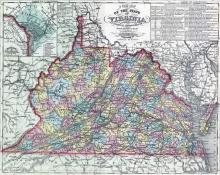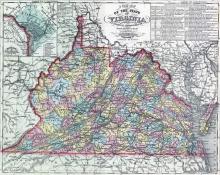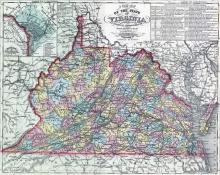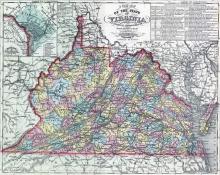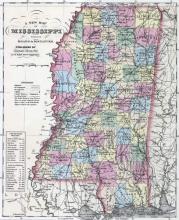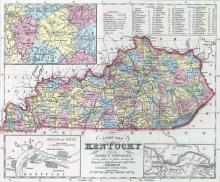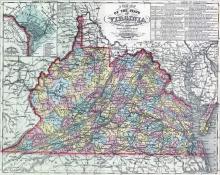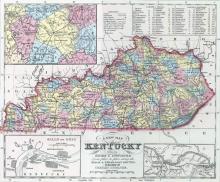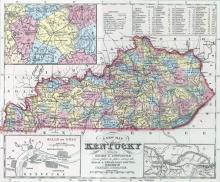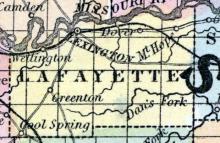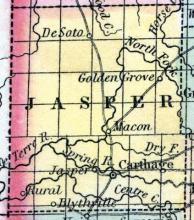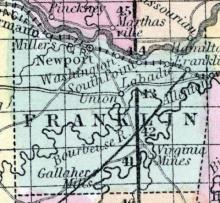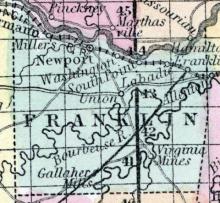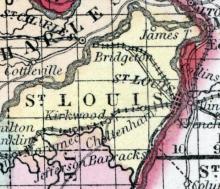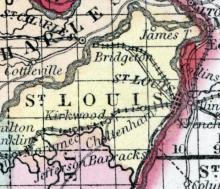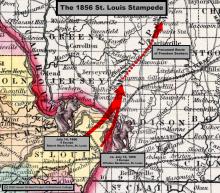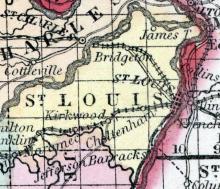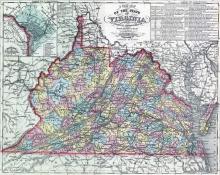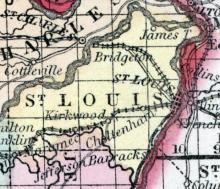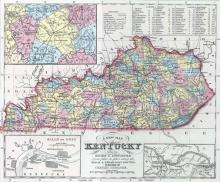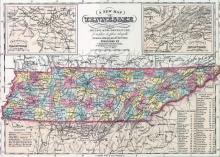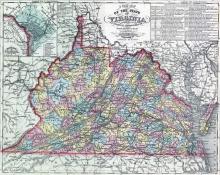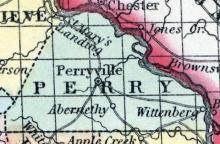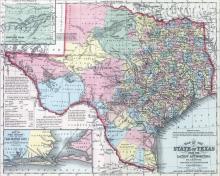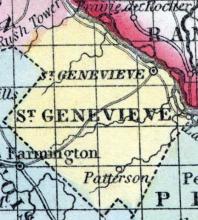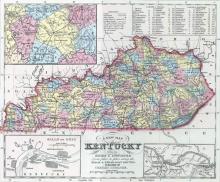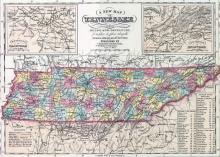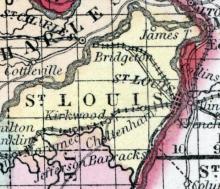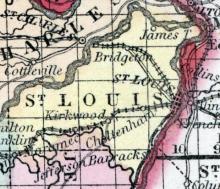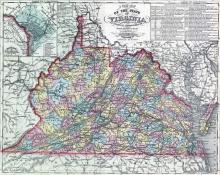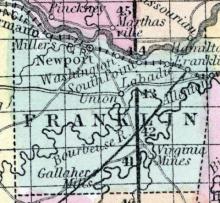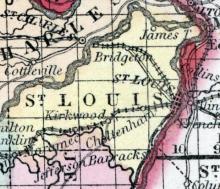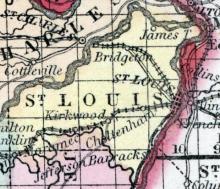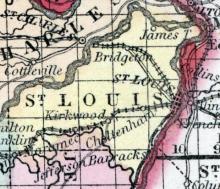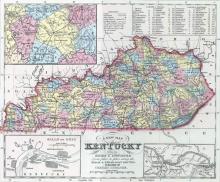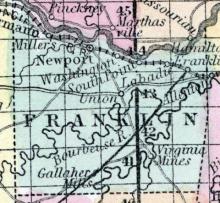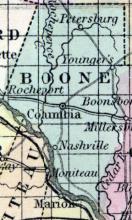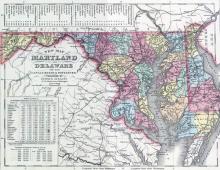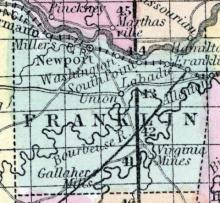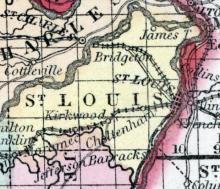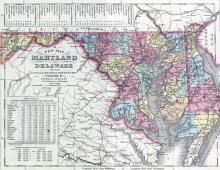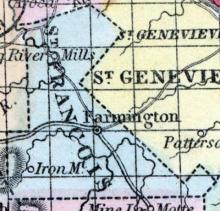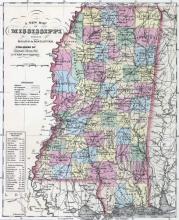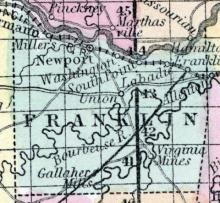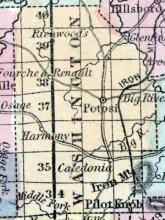On Saturday night, November 3, 1855, six enslaved people, heavily armed, mounted horses near Fairmont, Virginia and galloped northwards towards freedom. One man was recaptured, but the remainder apparently eluded re-enslavement, despite their enslavers offering a $1,000 reward for their recapture.
View All Escapes // 1840s // 1850s // 1860s
Displaying 151 - 200 of 314
Sometime in mid-November 1855, some 18 enslaved people--both men and women--escaped from Portsmouth and Norfolk, Virginia. Their fate remains unknown, but the escape did prompt concerned slaveholders to contemplate forming a squadron of slave patrolling vessels.
On Saturday night, November 24, 1855, six freedom seekers, who were not identified by name, escaped from Richmond, Virginia. Their destination is unknown, but Richmond journalists suspected that they had traveled along the "underground railroad, and are now, no doubt, on their way to the North."
On Saturday, December 1, 1855, some 11 enslaved people--seven men and four women--escaped from Richmond, Virginia. Their fate remains unknown.
Sometime in December 1855, some 40 enslaved people escaped in a "stampede" from Natchez, Mississippi. According to the Memphis, Tennessee Appeal, suspicions ran high that the freedom seekers "were carried off by some up-river boat, in the hands of Abolitionists of negro thieves." But the mode of escape, or ultimate fate of the freedom seekers remains unknown.
On Sunday night, December 16, 1855, seven enslaved people escaped in a "splendid carriage" from Millersburg in Bourbon county, Kentucky. But on attempting to cross the Ohio river near Maysville, their skiff leaked and filled with water, tragically drowning a woman and her three children. The survivors were re-enslaved.
On Christmas Eve 1855, six enslaved people--four men and two women--escaped from Middleburg in Loudon county, Virginia. Traveling on horseback and in a carriage, and heavily armed, the freedom seekers passed near Hood's Mill (near Eldersburg), Maryland the following day, where white residents sounded the alarm and started in pursuit. They shot and wounded one of the freedom seekers, and recaptured him, and later recaptured another of the men, who was named Joe.
In one of the most famous and tragic episodes of the fugitive slave crisis, a group of 16 freedom seekers escaped from Boone county, Kentucky on Sunday, January 27, 1856. After crossing the Ohio river, eight members of the Garner family were overtaken by a posse of slave catchers and federal officers. Forced to surrender, freedom seeking mother Margaret Garner killed her young child, rather than see the child be returned to the horrors of slavery.
Throughout late January and early February 1856, enslaved people launched a startling series of "stampedes" from Boone county, Kentucky and the surrounding counties. The Ohio river had frozen, temporarily forming an icy "bridge," and enslaved Kentuckians seized the moment for a mass exodus from bondage. Some estimates place the number of freedom seekers as high as 200 during this period.
On Friday night, February 1, 1856, six enslaved Kentuckians were "taken with a sudden leaving" and escaped into Ohio. They likely crossed the river by way of the "icy bridge" that frigid winter conditions had created, near California, Kentucky. Their ultimate fate remains unknown.
Around March 15, 1856 a 22-year-old enslaved man named Ned escaped from Berlin, Missouri. His enslavers, the firm Gratz & Shelby, advertised a $100 reward for his recapture.
Sometime in mid-April 1856, 30 enslaved people escaped from Asheville, North Carolina, bound for "parts unknown." They were claimed by slaveholder Samuel S. Simmons. An Asheville journalist remarked on this "stampede," noting: "This is 'running away' by the wholesale."
An enslaved man named Dow, about 23 years in age, escaped from Blytheville (modern day Union City) in what was then Jasper county, Missouri. His enslaver, John C. Cox, advertised a $300 reward for his recapture.
An enslaved lead miner named John Huddin escaped from Virginia Mines in Franklin county, Missouri on Saturday, June 7, 1856.
On Sunday, June 22, 1856, a 35-year-old enslaved man named Jessie Owens escaped, reportedly in the company of John Huddin, who had escaped two weeks prior, also from Virginia Mines. Owens's enslaver, B.S. Miles, advertised a $250 reward for his recapture.
On Tuesday, July 1, 1856, a roughly 20-year-old enslaved man named George escaped from Bonhomme, a short distance southwest of St. Louis. His enslaver, Abraham S. Fisher, advertised a $50 reward for his recapture.
Around July 10, 1856, three enslaved people escaped from the residence of prominent St. Louis citizen John O'Fallon. Apparently never recaptured, their escape may have been linked to the flight of eight enslaved people from slaveholder Robert Wash just days later. On Monday night, July 14, 1856, an enslaved family--a husband and wife, their three sons, two daughters and the wife's sister, escaped from slaveholder Robert Wash near St. Louis.
On Friday night, July 25, 1856, an enslaved man and an enslaved woman, who local newspapers did not identify by name, escaped from slaveholder John Muellberger's farm. The St. Louis Democrat reported that the two freedom seekers had reached Illinois.
On Sunday night, August 10, 1856, seven enslaved people escaped from Parkersburg, Virginia. Their ultimate fate remains unknown.
A 16-year-old enslaved woman named Nancy escaped from her enslaver, W.T. Christy of St. Louis, with the help of a white man named William Smith. The pair were captured on Illinois soil, four miles from Alton. Nancy was re-enslaved, and Smith was sentenced to five years in prison.
On Sunday, August 31, 1856, five enslaved people, whose names were not recorded, escaped from Jamestown, Kentucky into Ohio. Their fate remains unknown.
On Sunday night, August 31, 1856, a group of freedom seekers escaped from multiple slaveholders in Hopkins county, Kentucky. There were anywhere from 15 to 20 freedom seekers involved in the "stampede." One enslaved man from Tennessee was captured while attempting to join the group, but the fate of the others remains unknown.
Sometime in mid-September 1856, an enslaved railroad worker commandeered an engine near Sommerville, Tennessee. With "seven or eight other" enslaved people on board, they attempted to escape. Newspapers treated it with satire, labelling it a "novel negro stampede," but for the freedom seekers it meant the difference between a life of liberty or bondage. The group abandoned the engine some 12 miles outside of Sommerville, and fled to the woods.
On Sunday night, September 14, 1856, eleven enslaved people--eight adults and three children--escaped from Loudon county, Virginia. Their ultimate fate remains unknown.
On Sunday evening, September 28, 1856, an enslaved man named Westley (or West) escaped from the steamboad L.M. Kennett, while it was docked at Wilkinson's Landing along the Mississippi river south of St. Louis. His enslavers, T.H. Larkin & Co., advertised a $50 reward for his recapture.
Sometime in the fall of 1856, a "proposed negro stampede" was thwarted in Hallettsville, in Lavaca county, Texas. Several white men "of doubtful character" were alleged to have been involved in planning and aiding the escape plot. Placed on trial, a local jury returned a verdict of not guilty, but nonetheless required the men to leave the county in 48 hours. The number of enslaved Texans who attempted to escape was not specified.
On Saturday, October 18, 1856, two enslaved men, 24-year-old Antoine and Philip, aged between 35-40 years, escaped from Ste. Genevieve, Missouri. Their enslavers, B.T. Beauvais and Eloy Lecompte, respectively, each advertised separate $200 rewards for their individual recapture.
On Sunday night, October 19, 1856, a free African American preacher named Isaac McDaniel rescued from slavery his wife, Mary, their five-year-old son Daniel, and another family enslaved by Hannibal slaveholder John Bush: 32-year-old Anthony, his wife, 34-year-old Eliza, and their children, eight-year-old Margaret and six-year-old Lewis. Taking Bush's horse and carriage, McDaniel led the two families of freedom seekers out of slavery.
Sometime in early November 1856, two groups of freedom seekers, numbering 26 enslaved people, escaped from northern Kentucky. Fourteen freedom seekers left Kenton county, while another 12 escaped from near Maysville, Kentucky. Their ultimate fate remains unknown.
Reports described a stampede of free African Americans from Murfreesboro, Tennessee. Local whites had become angered by free Blacks' "pernicious influence among the slave population."
On Monday, January 5, 1857, a roughly 42-year-old enslaved man named Charles escaped in St. Louis from his enslaver, Francis J. Smith (the executor of deceased slaveholder Thomas Horine's estate), when Smith was traveling to Jefferson City. Smith advertised a $100 reward for Charles's recapture.
On Saturday, January 10, 1857, a 17-year-old enslaved man named Ben escaped from Bonhomme, near St. Louis. His enslaver, Henry Tyler, advertised a $100 reward for his recapture.
On Saturday night, January 10, 1857, eleven enslaved people escaped from a Richmond slave pen. Authorities expressed confidence they could recapture the freedom seekers, but their ultimate fate remains unknown.
A roughly 22-year-old enslaved man named Washington, or Wash, escaped from Berger, MIssouri in Franklin county, on Saturday morning, January 18, 1857. His enslaver, Theodore Bates, offered a $200 reward for his recapture.
On Friday, January 23, 1857, an enslaved 13-14 year old enslaved boy named Jack ran away from St. Louis. His enslaver, J.F. Neves, advertised a $50 reward for his recapture.
On Monday morning, January 26, 1857, an enslaved man named Lewis escaped St. Louis via the Ohio & Mississippi railroad, riding the trains to Cairo, Illinois. His enslaver, Barney Lynch, offered a $200 reward for his return.
A roughly 24-year-old enslaved man who went by the names of Mose or Keys escaped from Kirkwood, southwest of St. Louis, around 5pm on January 31, 1857. His enslaver, Thomas Sappington, advertised a $100 reward for his recapture.
In early February 1857, the frozen Ohio river provided a natural conduit to freedom for many enslaved Kentuckians. A family of six escaped from Covington, Kentucky during the first week of February, though a Cincinnati journalist noted that "numerous other stampedes have taken place along the line of the river."
On Sunday, March 8, 1857, a 21-year-old enslaved man named Jack ran away from Franklin county, Missouri. His enslaver, James B. Lewis, advertised a $500 reward for his recapture.
Sometime in March 1857, an enslaved man and child escaped from near Columbia in Boone county, Missouri. The editors of the Hannibal Messenger wondered aloud if "they ran off, were persuaded off, or stolen," but suspected that their flight had something to do with a spate of recent horse thefts, and concluded they had been "decoyed off."
On Saturday, April 11, 1857, five enslaved people escaped from the vicinity of Frederick, Maryland. Two freedom seekers fled from enslaver Abdiel Unkefer in Libertytown, Marlyand, and another three people escaped from slaveholding lawyer Dawson Hammond near the town of New Market. Their fate remains unknown.
On Wednesday, June 17, 1857, a freedman named Louis Liggens led his five enslaved children, William, Louis, Mary Jane, Sarah Ann and Ned out of St. Louis and towards freedom. Outraged at "such base ingratitude," the children's enslaver, John Finney, advertised a $700 reward for their recapture.
On Sunday morning, April 19, 1857, an enslaved man named Step escaped from Labadie station along the Pacific Railroad. His enslaver, F.J. North, advertised a $100 reward for Step's recapture.
Sometime during the weekend of May 16-17, 1857, an approximately 28-year-old enslaved man named Glasgow Emory escaped from St. Louis. His enslaver, H. Prouhet, advertised a $500 reward for his recapture.
On Saturday, May 30, 1857, five enslaved people escaped from Hagerstown, Maryland via horse, carriage, and buggy. They traveled to Chambersburg, where they apparently boarded the trains of the Cumberland Valley Railroad for Harrisburg. Although an initial report suggested the freedom seekers had been captured at Chambersburg, subsequent news items clarified that only the horses and carriages had been found.
Four escapees from near Iron Mountain, Missouri were tracked down near Sparta, Illinois by a posse of white Missourians. One of the escapees was killed in the violent confrontation, and another escapee was killed by two Illinoisans (who were later acquitted on charges of manslaughter in 1861). Only one freedom seeker successfully eluded recapture.
Throughout May 1857, some 31 enslaved people escaped from the vicinity of Fort Adams, Mississippi. Their names, or mode of escape, were not recorded. It remains unclear if any of the freedom seekers were recaptured.
On Saturday, June 13, 1857, an enslaved man who was not identified by name, aged about 23 years, escaped from Valle Mines in Franklin county. His enslaver, Bennett Thurmond, advertised a $300 reward for his recapture.
On Sunday, June 14, 1857, an approximately 28-year-old enslaved man named Charlie set out from Potosi in Washington county, Missouri. His enslaver, Michael Flynn, offered a $100 reward for his recapture.

